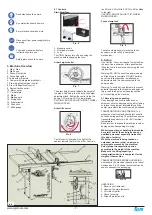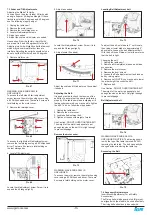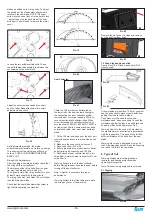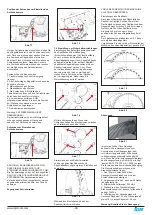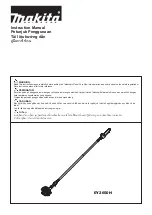
-
15
-
www.igmtools.com
Cutting a wood plank or sheet of plywood
lengthwise to reduce its width is called “ripping”.
To rip stock, hold the work with both hands
pushing it into the blade as well as firmly
against the rip fence so that it is cut straight.
• Never rip or cut wood without using the fence
or mitre gauge to guide it because the stock
could kickback.
• Always use the blade guard and riving knife
assembly when cutting wood. The riving knife
prevents the saw “kerf” (the slit cut by the
blade) from closing and binding the blade,
which can overload and/or stall the motor or
cause the blade to lift and eject the workpiece
towards the front of the saw at very high
speeds. The blade guard keeps your fingers
away from the blade and also reduces the
amount of sawdust flying free.
• Some jobs may require removing the riving
knife along with the cover. Do not forget to put
them back when you are done.
As you complete the rip, the wood will either
remain on the table, tilt up to be caught on
the end of the guard, or fall onto the floor (or
outfeed table). The waste part of the stock
remains on the table to be removed only after
the saw is stopped (unless it is large enough for
immediate safe removal).
If the work to be ripped is narrow, it is safer
to use a push stick, rather than the hands, to
feed it into the blade Push sticks with non-slip
grippers can be purchased, but a shop-made
one works just as well. When ripping extremely
narrow stock that may not clear the width of
the blade guard, or very thin material such
as panelling, which may slip between the
underside of the fence and the table surface,
a strip of wood as an auxiliary guide can be
attached to the fence.
WARNING: Keep the blade guard installed and
in the down position. Failure to do this could
result in serious personal injury or death.
WARNING: Never reach in towards the blade
while the blade is still spinning! whenever a rip
cut is completed, turn off the saw and wait for
the blade to come to a complete stop before
reaching in to remove the workpiece or the
waste material.
8.2 Bevel Ripping
Pic. 87
Bevel ripping is performed the same as ripping
but with the saw blade set to an angle not
perpendicular with the table surface. To tilt the
blade to the left, anywhere between 0° and 45°.
This is used most often when cutting bevels,
compound mitres or chamfers.
After changing the bevel angle verify the
alignment of the guard and splitter; make sure
there is clearance with the saw blade.
8.3 Ripping small workpieces
Do not attempt rip cuts if the work piece is too
small, as this will oblige you to place your hands
too close to the blade and put you at serious
risk of injury. When ripping narrower widths; use
a push block or a push stick in order to avoid
placing hands near the blade.
8.4 Cross cutting
Cutting against the grain, to shorten the length
of a board is crosscutting. With some smaller
sized and rectangular pieces, you often have
the choice of ripping or crosscutting. Always
use the mitre gauge, when crosscutting; never
cut a piece unsupported. The mitre gauge may
be used in either slot, but most operators prefer
the left groove for typical work. When the blade
is tilted for bevel cutting, use the table slot that
does not cause interference with your hand or
the saw blade guard.
To begin crosscutting, place the work on the
mitre gauge and, with the motor OFF, slide it up
close to the blade to align the outer edges of
the teeth with your cut mark (see pic).
Keep a firm grip as you pull the mitre gauge
and the wood back away from the blade. Lower
the blade guard, turn on the saw and make the
cut. When the work is cut through, move one or
both cut pieces.
Pic. 88
Warning: When cross-cutting round stock it
is necessary to secure the workpiece against
rotation by using a suitable jig.
8.5 Bevel cross cutting
This procedure is the same as cross cutting
except that the blade is set to an angle other
than 0. After changing the bevel angle, verify
the alignment of the guard and splitter and
verify that there is clearance with the saw blade.
Pic. 89
8.6 Mitre cuts
This operation is the same as cross cutting,
except the mitre gauge is set to an angle. Hold
the work piece firmly against the mitre gauge
and feed the workpiece slowly into the blade to
prevent it from moving during the cut.
Pic. 90
9. Maintenance
To keep you Laguna Tools machine in top
performance for many years please follow
this maintenance schedule and refer to any
instructions.
Daily Check:
• Loose mounting bolts
• Damaged saw blade
• Damaged riving knifes, splitters, or blade
guards
• Worn or damaged wires
• Any other unsafe condition
Weekly Maintenance:
• Clean table surface and mitre slot grooves
• Clean and protect cast-iron table
• Clean rip fence
Monthly Maintenance:
• Clean/vacuum dust buildup from inside
cabinet and off motors.
• Check/replace belt for proper tension, damage
or wear.
Every 6–12 Months:
• Lubricate trunnion slides.
• Lubricate worm gear.
• Lubricate leadscrew.
• Lubricate gearing and gearboxes.







